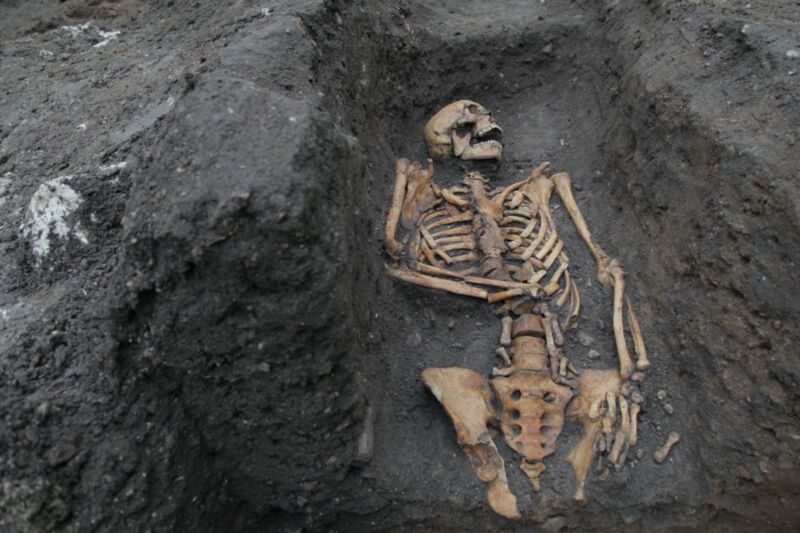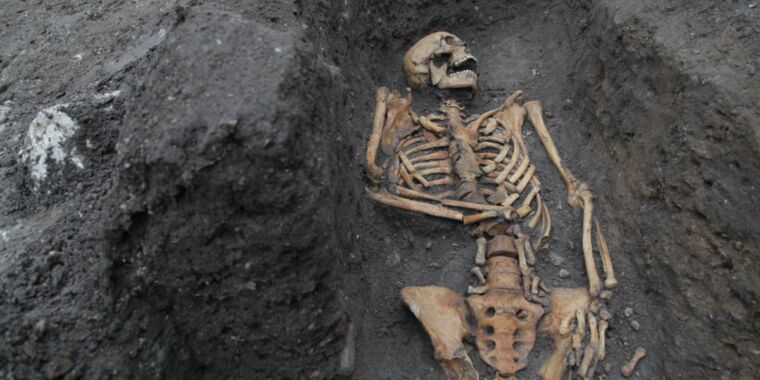
There’s rarely time to write about every cool science-y story that comes our way. So this year, we’re once again running a special Twelve Days of Christmas series of posts, highlighting one science story that fell through the cracks in 2020, each day from December 25 through January 5. Our final post in the 2021 series: Skeletal remains excavated from medieval sites in Cambridge reveal occupational and social disparities in the population.
A working class woman who suffered from domestic violence. A friar who may have been the victim of a horse-and-cart hit-and-run. Those are just two examples of the remains of 314 people excavated from three very different medieval burial sites in Cambridge, England. The evidence of skeletal trauma on many of those remains sheds light on what medieval Cantabrigian lives were like, in terms of occupation, living conditions, and social status, according to a paper published last January in the American Journal of Physical Anthropology.
The research stems from the After the Plague project at Cambridge University’s Department of Archaeology, which explores how historical conditions influence health and how health, in turn, shapes history. The project particularly focuses on the Black Death period (1347-1350 CE) in later medieval England, which wiped out between a third and a half of Europe’s population.
“By comparing the skeletal trauma of remains buried in various locations within a town like Cambridge, we can gauge the hazards of daily life experienced by different spheres of medieval society,” said lead author Jenna Dittmar, a paleopathologist at Cambridge. “We can see that ordinary working folk had a higher risk of injury compared to the friars and their benefactors or the more sheltered hospital inmates.”
By the 13th century, Cambridge was a thriving market town with an active river port and a rural agricultural component on the outskirts of town. Its famed university had only just been founded. “Although a small town by today’s standards, Cambridge presented a varied social landscape,” the authors wrote. Most of the population were laborers: agricultural workers (such as plowmen and shepherds), construction workers (such as carpenters, tilers, masons, thatchers), and artisans (such a shoemakers and tailors).
The specialized trades were primarily practiced by men, according to the authors, but women found work brewing ale, washing clothes, weaving, working in the fields, and entering domestic service. The town also had several ecclesiastical institutions, including Cambridge University itself, which was founded sometime between 1208 and 1210 CE. The friars would have been scholars or would have been engaged in various pastoral duties, with a bit of manual labor in the mix. Like every town, Cambridge had its share of poverty-stricken people, as well as a few especially prosperous families, with considerable property and servants.
Dittmar and her co-authors chose to examine remains from three different burial sites representing a broad strata of Cambridge society. The first is the Parish of All Saints by the Castle, first excavated in the early 1970s. Likely founded between 940-1100 CE, the parish would have been where the vast majority of the ordinary people were buried. It was eventually merged with a neighboring parish in 1365 CE, after the Black Death devastated the Cambridge population.
The second site is the Hospital of St. John the Evangelist, founded around 1200 CE. This charitable, ecclesiastical institution catered to the poor and infirm until it was dissolved to create St. John’s College. Those buried here would likely have led lives of poverty, receiving food, lodging, and clothing from the hospital.
Finally, there is the Augustinian friary in Cambridge, established around 1280 CE, with burial grounds catering to friars and wealthy townspeople.
-
The remains of a person buried in the Augustinian friary.
Nick Saffell/University of Cambridge -
Remains of several individuals unearthed on the former site of the Hospital of St. John the Evangelist.
Nick Saffell/University of Cambridge -
X-rays of butterfly fractures to both femora of an adult male buried in the Augustinian friary.
Jenna Ditmar -
Jenna Dittmar at work on the After the Plague project at the University of Cambridge’s Department of Archaeology.
University of Cambridge -
Members of the Cambridge Archaeological Unit at the excavation site of the Hospital of St. John the Evangelist.
Cambridge Archeological Unit -
Map of Cambridge, circa 1350.
Vicki Herring/University of Cambridge
Dittmar et al. found that, in general, male skeletons were more likely to show signs of fractures than female skeletons (40 percent versus 26 percent). About 44 percent of the working-class skeletons had fractures, compared to 32 percent of skeletons from the friary site and 27 percent of skeletons from the hospital site—perhaps because the inhabitants of the latter often included chronically ill or frail people who didn’t engage as much in risky activities. The older the individuals, the more likely they were to have fractures.
Fractured ribs were the most common injury. “These were people who spent their days working long hours doing heavy manual labor,” said Dittmar. “In town, people worked in trades and crafts such as stonemasonry and blacksmithing, or as general laborers. Outside town, many spent dawn to dusk doing bone-crushing work in the fields or tending livestock.”
Their skeletal remains are testaments to lives spent working hard. One skeleton had a fractured clavicle, likely sustained by falling onto the shoulder and trying to break the fall with an outstretched hand. Another skeleton of an older man showed evidence of several broken ribs, as well as a fractured clavicle—likely the result of blunt force trauma sustained from falling from a height or being crushed or pinned by livestock.
“Those buried in All Saints were among the poorest in town, and clearly more exposed to incidental injury,” said Dittmar. “Men may have worked in the fields with heavy ploughs pulled by horses or oxen, or lugged stone blocks and wooden beams in the town. Many of the women in All Saints probably undertook hard physical labours such as tending livestock and helping with harvest alongside their domestic duties.”
One female skeleton buried in the parish grounds showed signs of domestic violence: numerous fractures that had healed before she died, including broken ribs, a fractured jaw and foot, and fractured vertebrae. “It would be very uncommon for all these injuries to occur as the result of a fall, for instance,” said Dittmar—hence the suggestion of domestic violence.
The team found fractures halfway up both femurs (thigh bone) of one skeleton from the friary, which is a common injury today in those hit by cars. “Whatever caused both bones to break in this way must have been traumatic and was possibly the case of death,” said Dittmar. “Our best guess is a cart accident. Perhaps a horse spooked and he was struck by the wagon.” Another friar showed signs of defensive wounds on one arm and blunt force trauma to the skull, which sounds like perfect fodder for a medieval murder mystery.
Somewhat surprisingly, Dittmar et al. didn’t find any evidence of sharp-force trauma, i.e., the sort inflicted by weapons. “It has been said that homicide was so common that in London and Oxford an individual was more likely to be murdered than die from an accident,” the authors wrote. “It may be that bladed weapons such as daggers and knives were not commonly used to commit violent acts in Cambridge,” even though 73 percent of murders in this period were committed using cutting or piercing weapons.
DOI: American Journal of Physical Anthropology, 2021. 10.1002/ajpa.24225 (About DOIs).








